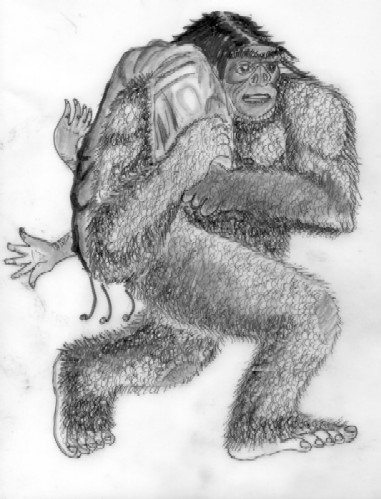
Whether you call them Sasquatch contactees, Bigfoot magnets, Forest Giant abductees, or Wild People habituators, it is clear a new collection of people are to be reckoned with in hominology. What do you think of this modern trend?
June 26, 2010

Whether you call them Sasquatch contactees, Bigfoot magnets, Forest Giant abductees, or Wild People habituators, it is clear a new collection of people are to be reckoned with in hominology. What do you think of this modern trend?
Here is a flashback posting from March 4, 2007, which touched on this topic. What are your thoughts?
The image above may be enlarged by clicking on it. Janice Coy is shown by the Russian artist Lidia pulling out hair from the hand of the Carter family-named “Fox,” when giving him some garlic. March 2004. This montage was created by Lidia using Igor Bourtsev’s photograph of Coy with Bourtsev as the stand-in for Fox. Coy says she recreated the interaction while standing in the same dress and position as then. After the first draft drawing, Coy corrected Lidia several times until the artist achieved the correct graphic similarity to the events, as claimed by Coy. Used with permission from Bourtsev.
In March 2006, a Tennessee Bigfoot video was posted and discussed by Craig Woolheater here. [The links to the video are dead, unfortunately, and appeared to have been pulled.] The video was associated with the two main characters in this tale, Mary Green and Janice Coy.
The background to the videotape was that the Coy/Carter family claimed they have been in communication with a Bigfoot family for over five decades. Many in the Sasquatch studies community feel the very nature of this claim brings discredit to the entire science of hominology, especially without firm proof after all these decades. What do you think?
A few years ago, Craig Woolheater and I were discussing the similarity among people within a group of individuals whom he calls “Sasquatch magnets.” Craig has a specific definition in mind for the personalities he feel can be identified thusly:
There are a lot of people that would lead you to believe that they have repeated encounters with these creatures. I’m talking about people who make claims of going into the woods and finding tracks, often numbering in the hundreds, hearing mimicked vocalizations (most often owls) or seeing these things….every time they go out. I want to be clear here, I’m not talking about habituation cases. I’m talking about continual chance encounters.
(Although “habituation” is less frequently used that “habitation,” I’ll use “habituation” throughout this blog, to follow Craig’s initial use of the word here in this definition of his. Perhaps “habitation” versus “habituation” is the topic for a long discussion too, but back to Sasquatch magnets and Bigfoot contactees, for now.)
Craig sees a distinctive difference between these “Sasquatch magnets” and the habituation cases. I think they are only different points on a continuum.
After I got over my initial shock that Craig wasn’t discussing those funny things that look like tiny, tiny Bigfoot tracks that people put on their refrigerators (yep, I have some on mine), I began to focus on his content. These kinds of magnetic folk have been around a long time, and since the 1970s, I’ve been collecting their stories and classifying them as “Bigfoot contactees.”
In my 2003 book, Bigfoot! The True Story of Apes in America, I even wrote about two sinister and really atypical Bigfoot contactees named Charles Starkweather and Cary Anthony Stayner. Beside seeing Bigfoot routinely, both Starkweather, in the 1950s, and Stayner, in the 1990s, additionally, were serial killers. (The later murderer, the so-called Yosemite Killer, even wrote me from prison in 2006, and sent along his drawings of Bigfoot, which I included in the Bates College / Kansas City Artspace cryptozoology exhibition.)
Who is on your short list of Bigfoot contactee serial killers?
Meanwhile, all kinds of people have been labeling each other with the “contactee” moniker.
Maryland Bigfoot researcher Mark Opsasnick called the late Washington State Bigfoot tracker Paul Freeman, a Bigfoot contactee.
Bad Boy Erik Beckjord called Jack Lapseritis, a Bigfoot contactee. (No telling what Lapseritis called Beckjord.) Many people have called Beckjord a contactee, especially after he said “he” was Mothman because his out-of-body experiences were seen and identified incorrectly (?) as Mothman. We don’t even need to tick down all the Bigfoot 4D claims he’s made to put Beckjord in the contactee file. Or his pre-death media firestorm he created saying he had taken psychic photos of the late Nicole Simpson and Ron Goldman.
Jack Lapseritis in his book, The Psychic Sasquatch, spends his time discussing interviews with several Bigfoot contactees. (You don’t want to hear what the late René Dahinden called Lapseritis.)
Ken Dashow, host of the radio program, “Edge of Reality,” called Pennsylvania resident Stan Johnson, a Bigfoot contactee, after Johnson said he had been in touch with both the Heaven’s Gate suicide victims (after they killed themselves) and the “Seven Races of Bigfoot.”
“Jan Klement”, an elusive character in Pennsylvania hairy hominoid history, has to be termed a Bigfoot contactee.

(2010 note: Needless to say, Autumn Williams now has added this collection of stories by talking of “Mike” in her book, Enoch.)
What names are on your list?
Nowadays, there’s a whole group of folks claiming Bigfoot habituation, the sometimes seemingly permanent mutual living arrangement between the humans and a family or group of Sasquatch close to a rural setting or in a nearby woods. The humans are merely the latest group who, for all practical purposes, are the ultimate Bigfoot contactees.
Thom Powell’s folksy book, The Locals: A Contemporary Investigation of the Bigfoot/Sasquatch Phenomenon, is a study in habituation, and straightforwardly supports the tales from what can loosely be called Bigfoot contactees.
Are these merely just new outrageous, unsubstantiated claims regarding frequent sightings of Bigfoot wearing new clothing of the old 1970s’ Bigfoot contactees? Opinions vary. Powell is in a growing school of followers who doubt the mainstream Bigfoot theories and thoughts, as expressed by most chroniclers of Sasquatch and Bigfoot encounters and history.
Craig Woolheater has pointed to this part of what John Green has to say about such claims:
There is nothing new about people claiming that they have been able to make detailed observations of Sasquatch and know all about their appearance and behavior. People with stories like that have turned up numerous times in the past 45 years, and so far the end result has always been disappointment. If you are involved with such a person, be cautious. I have watched former colleagues get so deeply committed and then so sharply disillusioned that it soured them on the whole subject and they dropped out.
Similarly there is nothing new about people believing they see or hear or smell evidence of Sasquatch presence almost every time they go out in the woods.
But unidentified sounds and smells are just that, unidentified sounds and smells, and shapes found in photographs that could be Sasquatch could also not be. There are other agencies besides Sasquatch that can take food, make beds of vegetation, break trees and branches, move rocks, pound on things or make interesting depressions in the ground.
There have been cases where people have gone far beyond any reasonable extreme to fool someone with manufactured evidence of Sasquatch presence, and also cases where people have gone pretty far to fool themselves. Try not to add to that list.
All of us surely hope that some day some such story will be proved to be true, and at my age I tend to wish very hard that it will happen soon, but my experience offers no reason for optimism. Many years ago I decided that people who saw so much and knew so much were a long way ahead of me, so they had no need of my help and I would just await definite results. I am still waiting.
For anyone hoping to persuade mainstream science to take on this quest and provide the expertise and resources to bring it to a conclusion, episodes of this sort do real harm. Those who take them seriously end up looking foolish, and the prospect of looking foolish is surely one of the main reasons why few of the scientists that we know have an interest in this subject do anything about it, and why there is no financial or institutional support for those that do take it up. – John Green
Of course, the longest running, most accepted Bigfoot contactee story would have be the Albert Ostman encounter in 1924, where Ostman claimed he was kidnapped by a male Sasquatch and taken in his sleeping bag back to the Sasquatch’s canyon-enclosed campsite. Remarkably, there’s general agreement among many of us about Albert Ostman. John Green, Mark A. Hall, Ivan T. Sanderson, myself, and many others support and consider the Ostman story one of great merit.

This is an interpretation of the Albert Ostman kidnapping by French hominologist Christian Le Noel. Used with permission from Le Noel.
Ostman’s continuing longterm event contained far more details than momentary observations of random meetings with Sasquatch. That no one else has observed Sasquatch females gathering food, or living in family groups on the scale detailed by Ostman is not a good counter argument to say there is no reality to the Ostman sighting.
A few of the Bigfoot contactees and habituation stories may turn out to be true, and some do contain elements that confirm the Albert Ostman story. But then again, all of the post-Ostman Bigfoot contactees could be making up their tales based upon Ostman’s descriptions – and combinations of elements from many other stories. It’s really difficult to tell until there’s a Bigfoot in hand, so to speak, and it is a verified species. Someday we may all look back and exclaim, “Oh, that’s what they were talking about!”
Until that discovery, the file of Bigfoot contactees goes. Who else would be on your list of Bigfoot contactees?
What do you think of this entire topic?
About Loren Coleman
Loren Coleman is one of the world’s leading cryptozoologists, some say “the” leading living cryptozoologist. Certainly, he is acknowledged as the current living American researcher and writer who has most popularized cryptozoology in the late 20th and early 21st centuries.
Starting his fieldwork and investigations in 1960, after traveling and trekking extensively in pursuit of cryptozoological mysteries, Coleman began writing to share his experiences in 1969. An honorary member of Ivan T. Sanderson’s Society for the Investigation of the Unexplained in the 1970s, Coleman has been bestowed with similar honorary memberships of the North Idaho College Cryptozoology Club in 1983, and in subsequent years, that of the British Columbia Scientific Cryptozoology Club, CryptoSafari International, and other international organizations. He was also a Life Member and Benefactor of the International Society of Cryptozoology (now-defunct).
Loren Coleman’s daily blog, as a member of the Cryptomundo Team, served as an ongoing avenue of communication for the ever-growing body of cryptozoo news from 2005 through 2013. He returned as an infrequent contributor beginning Halloween week of 2015.
Coleman is the founder in 2003, and current director of the International Cryptozoology Museum in Portland, Maine.
Filed under Bigfoot, Books, Breaking News, Cryptomundo Exclusive, Cryptotourism, CryptoZoo News, Cryptozoologists, Cryptozoology, Expedition Reports, Pop Culture, Sasquatch